
Rolf Singer was a German mycologist and taxonomist of gilled mushrooms (agarics).
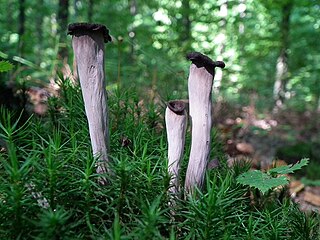
Craterellus is a genus of generally edible fungi similar to the closely related chanterelles, with some new species recently moved from the latter to the former. Both groups lack true gills on the underside of their caps, though they often have gill-like wrinkles and ridges.

Macrolepiota procera, the parasol mushroom, is a basidiomycete fungus with a large, prominent fruiting body resembling a parasol. It is a fairly common species on well-drained soils. It is found solitary or in groups and fairy rings in pastures and occasionally in woodland. It is widespread in temperate regions of Eurasia and possibly North America. Further research is needed to confirm whether specimens found in North America are the same species.
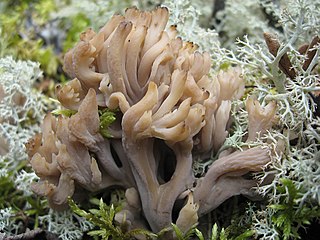
Clavulina cristata, commonly known as the wrinkled coral fungus, white coral fungus or the crested coral fungus, is a white- or light-colored edible coral mushroom present in temperate areas of the Americas and Europe. It is the type species of the genus Clavulina.

Lentinus is a genus of fungi in the family Polyporaceae. The genus is widely distributed, with many species found in subtropical regions.
Graphidastra is a genus of lichen-forming fungi in the family Roccellaceae.
Neoclitocybe is a genus of fungi in the family Tricholomataceae. The widespread genus contains 10 species that are especially prevalent in tropical regions.

Cantharellus lateritius, commonly known as the smooth chanterelle, is a species of edible fungus in the mushroom family Cantharellaceae. The species has a complex taxonomic history, and has undergone several name changes since its first description by American mycologist Lewis David de Schweinitz in 1822. The fruit bodies of the fungus are brightly colored yellow to orange, and usually highly conspicuous against the soil in which they are found. At maturity, the mushroom resembles a filled funnel with the spore-bearing surface along the sloping outer sides. The texture of the fertile undersurface (hymenium) of the caps is a distinguishing characteristic of the species: unlike the well-known golden chanterelle, the hymenium of C. lateritius is much smoother.

Pholiota flammans, commonly known as the yellow pholiota, the flaming Pholiota, or the flame scalecap, is a basidiomycete agaric mushroom of the genus Pholiota. Its fruit body is golden-yellow in color throughout, while its cap and stem are covered in sharp scales. As it is a saprobic fungus, the fruit bodies typically appear in clusters on the stumps of dead coniferous trees. P. flammans is distributed throughout Europe, North America, and Asia in boreal and temperate regions. Its edibility has not been clarified.
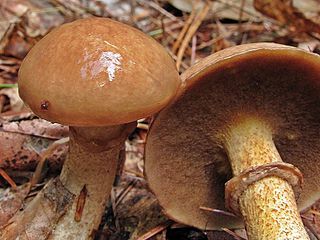
Suillus acidus is an edible species of mushroom in the genus Suillus. The species was first described by Charles Horton Peck as Boletus acidus in 1905.
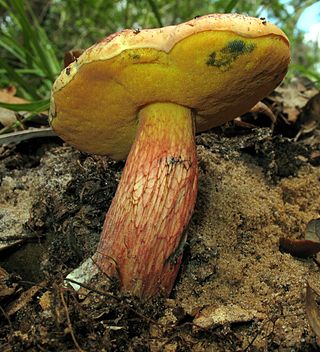
Exsudoporus floridanus is a species of edible bolete mushroom in the family Boletaceae. In 1945, American mycologist Rolf Singer described a species he found in Florida during his 1942–3 tenure of a Guggenheim Memorial Fellowship. He originally described it as a subspecies of the eastern North American species Boletus frostii, but later considered it worthy of distinct species status in a 1947 publication. Based on morphological and phylogenetic data, Vizzini and colleagues transferred this species to a newly described genus Exsudoporus in 2014. Due to lack of sufficient sequences, Wu et al. (2016) were reluctant to accept Exsudoporus and considered it a synonym of Butyriboletus, so they proposed a new combination Butyriboletus floridanus. However, following phylogenetic and morphological analyses clearly resolved Exsudoporus as a monophyletic, homogenous and independent genus that is sister to Butyriboletus.

Morchella deliciosa is a species of edible fungus in the family Morchellaceae. It was first described scientifically by Elias Magnus Fries in 1822. It is a European species, although the name has erroneously been applied to morphologically similar North American morels.

Macrolepiota mastoidea is a species of mushroom producing fungus in the family Agaricaceae.
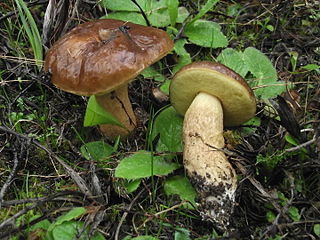
Leccinellum corsicum is a species of bolete fungus in the family Boletaceae. It grows in mycorrhizal symbiosis exclusively with rockroses in Mediterranean Europe and North Africa. The fungus was originally described as new to science in 1896 by French mycologist Léon Louis Rolland as a species of Boletus. Andreas Bresinsky and Manfred Binder transferred it to the newly circumscribed genus Leccinellum in 2003.

Psathyrella spadicea or Homophron spadiceum, commonly known as the chestnut brittlestem, is a species of agaric fungus in the family Psathyrellaceae. The fungus was originally described by German mycologist Jacob Christian Schäffer in 1783 as Agaricus spadiceus. Rolf Singer transferred it to the genus Psathyrella in 1951, in which it was classified in the section Spadiceae. In 2015 Örstadius & Larsson recreated the genus Homophron for a group of psathyrelloid mushrooms with no veil and with light-coloured spores, and P. spadicea was moved to the new genus.
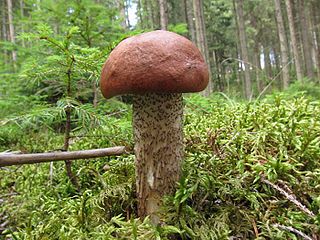
Leccinum vulpinum, commonly known as the foxy bolete, is a bolete fungus in the genus Leccinum that is found in Europe. It was described as new to science by Roy Watling in 1961. An edible species, it grows in mycorrhizal association with species of pine and bearberry.

Xanthoconium affine is an edible species of bolete fungus of the genus Xanthoconium. First described as a species of Boletus by Charles Horton Peck in 1873, it was placed in its current genus by Rolf Singer in 1944.
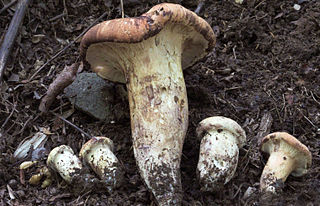
Gloeocantharellus purpurascens, commonly known as the Indian Creek mushroom or violet-staining chanterelle, is a species of fungus in the family Gomphaceae native to North America and French Guiana.

Gomphidius smithii is an edible mushroom in the family of Gomphidiaceae that is found in the Pacific Northwest in North America.

Lentinus levis is a species of edible fungus in the family Polyporaceae. It was described by Miles Joseph Berkeley and Moses Ashley Curtis in 1853 and given its current name in 1915 by William Murrill. As a saprotroph, it can be cultivated. In nature it grows in subtropical to tropical climate. It is recognized and sometimes collected as a food by Huichol people of Mexico, although they prefer eating other, less chewy mushrooms. For a long time thought to be a member of Pleurotus genus, it has been moved to genus Lentinus.

















